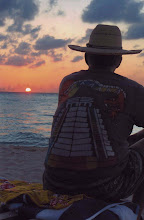The story goes that he and one of his brothers were out searching for lost cows when they came upon the ancient ruins. The second story was that a Ute Indian showed the ruins to Mr. Wetherill. If you have ever been to Mesa Verde, you would tend to believe the second one. You don't just wander up the mesa.

From the farthest ruin, looking west, you can see down into the desert area of the Four Corners, Mexican Hat, Shiprock and Monument Valley. What do you mean "You have never been?" What are you waiting for?
The book I purchased south of Mesa Verde, at Chaco Canyon, is called Anasazi. It is about the life of Mr. Wetherill. The Navajo called him Anasazi, which means Ancient Ones -- referring to the cliff dwellers of Mesa Verde and the canyon dwellers of Chaco Canyon in New Mexico.
New Mexico is actually a state in our United States. I have actually had to explain that to my neighbor. She asked if Mexico and New Mexico were the same. Richard and his wife actually built a ranch and trading post right in front of the most famous ruin, Pueblo Bonita (which means pretty village in Spanish), at the Chaco. There is no sign of it now. Only the grave of Mr. Wetherill is left inside the horse corral. There are, as well, many Navajo graves there – those who wanted to be buried next to him.
Marietta, his wife, always referred to him as Mr. Wetherill. It was a sign of the times -- although she was twenty years younger than her husband.
While we were there, Sandy purchased the book, Marietta Wetherill, Life with the Navajo in Chaco Canyon. I feel you have to read both books to understand the whole story. The following is an excerpt from Marietta's book.

Both Grandmother Palmer and Grandmother Hoag were religious, the two I was named for, Mary and Etta. Grandmother Hoag was a wonderful woman and housekeeper and was good to everybody. She wanted the words, "I have no enemies." chiseled on her tombstone. All the people she knew were her friends and she hoped to meet them in the hereafter and she was sure she would.
I remember sitting by Grandmother Palmer’s bed when she was dying. I was only twelve then. I told her God had been good to her and he was going to take her right to heaven. "That’s what makes me feel so bad," she said. "I have been a good Congregationalist all my life and I will go to Heaven, I know that, but I'll be so lonesome there."
"What do you mean?" I asked.
She said, "Your father's a wicked man, he don't believe in God at all, and your Grandfather (William Palmer), he's wicked too. They would never have him in heaven the way he is. And look at Jess and Corey, they belong to the Episcopal Church, they would never go to heaven; and I won't have anybody there."
I've thought of that a lot. I wouldn't want to be there in heaven, either. Of course, I got my idea of religion from the Indians. The Navajo didn't believe in a heaven after death.
Mr. Wetherill was shot and killed at the Chaco by a Navajo named Chis-chilling-begay. Whether he deserved it or not will be for you to decide once you have read both books.
Marietta as a youngster was nearly abducted into an Apache tribe because with her dark hair pulled back into pig tails and parted down the middle she looked Navajo or Apache. She spoke both languages. Years later she again met the Apache who wanted to take her into his tribe -- at the World’s Fair in St. Louis, Missouri in 1902. His name was Geronimo. I did not make that up. Curiously enough, one of my relatives worked at that World’s Fair as a carpenter -- when he ran out of money coming back from the Klondike in Alaska. His name was Ernest Bachand and he was from Canada. He was 72 at the time.
Marietta Palmer Wetherill said she lived like a gypsy the rest of her life, but she did not refer to much of it in her taped recollections. At first she lived to the east of the Chaco, at Cuba, New Mexico. (If you go through Cuba, stop and eat at the Mexican restaurant called El Bruno's Restaurante Y Cantina. Eating there is worth the whole trip to Chaco.)


Me, with Kathy and Charles Gregory of Albuquerque, in front of El Bruno's.


She moved from New Mexico to operate a small ranch and trading post at Chambers, Arizona, and worked in stores in Utah. She moved to a little house on Peach Avenue in Albuquerque, New Mexico during her later years. She died in her sleep there at age 77, on July 11, 1954. Her ashes were buried near Mr. Wetherill’s grave along the cliff near Pueblo Bonito at the Chaco.

